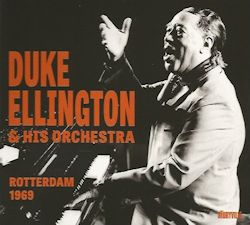1. Take the “A” Train/C Jam Blues
2. Kinda Dukish/Rockin’ in Rhythm
3. Take the “A” Train
4. Up Jump
5. La Plus Belle Africaine
6. Come Off the Veldt
7. El Gato
8. Black Butterfly
9. Things Ain’t What They Used To Be
10. Don’t Get Around Much Anymore
11. Medley 1: Caravan/Mood Indigo/Sophisticated Lady
12. Medley 2: Making That Scene/It Don’t Mean a Thing If It Ain’t Got That Swing/Be Cool and Groovy for Me
13. Satin Doll
14. R.T.M.
15. In Triplicate/Satin Doll
Cat Anderson, Cootie Williams, Ambrose Jackson, Mercer Ellington, Nelson Williams, Benny Bailey –Trumpets
Lawrence Brown, Chuck Connors – Trombones
Russell Procope – Alto sax, clarinet
Johnny Hodges – Alto sax
Norris Turney – Alto sax, tenor sax, clarinet, flute
Harold Ashby – Tenor sax, clarinet
Paul Gonsalves – Tenor sax
Harry Carney - Baritone sax, clarinet, bass clarinet
Duke Ellington – Piano
Victor Gaskin – Bass
Rufus Jones – Drums
Wild Bill Davis – Organ (tracks 13, 14)
Tony Watkins – Vocals
Duke Ellington’s Orchestra toured Europe in 1969. It was only five years before his death but he was still as fit and enthusiastic as ever. His band played
two concerts at the De Doelen Concert Hall in Rotterdam in November, and this album was recorded at the second of them. The CD includes no personnel
details, so I have taken them from the Storyville label’s website.
The concert begins with (of course) Take the “A” Train, which is cleverly blended into C Jam Blues. There follows Kinda Dukish
leading (of course) into Rockin’ in Rhythm. Then comes a longer version of Take the “A” Train featuring solos by Ellington (with hints of
waltz time) and Cootie Williams (echoing Ray Nance’s original solo). Paul Gonsalves, characterised by Duke as “the hero of the Newport Jazz Festival”
features in Up Jump, a very up-tempo number which exhibits Paul’s miraculous ability to play more notes per minute than you can count, while still
remaining melodic. Ellington describes it as “tenor saxophonic callisthenics”.
The longest track on the CD is La Plus Belle Africaine, which Duke described as having been composed in anticipation of the orchestra's "first
visit to Africa -- after writing African music for 35 years!" This number’s outstanding soloist is Harry Carney. A piano interlude is punctuated by
rhythmic hand-clapping. Next Rufus Jones provides a drum solo lasting no more than a couple of minutes. Cat Anderson’s feature in El Gato is
marred by his imprecise intonation, especially when he tries reaching for the heights. But precision is the hallmark of the trumpet section’s massed
playing towards the end.
Johnny Hodges’ alto sax in slightly under-recorded in Black Butterfly but this doesn’t stop his emotive, lyrical grace from coming through,
especially when he rises higher in the mix. The whole band swings mightily behind Hodges when he solos in Things Ain’t What They Used To Be.
Johnny again takes flight in Don’t Get Around Much Anymore. This set of three numbers illustrates Hodges’ supremacy as a rhapsodic soloist.
Then come two medleys: one after the other. The difference is that the first one consists of instrumentals, while the second one features vocalist Tony
Watkins, who is described in the sleeve-notes as “something of an acquired taste for hard-core fans of Ellington’s music”, although such fans are unlikely
to accept any singer with Ellington unless they come up to the standard of Ivie Anderson or Adelaide Hall. Tony Watkins sings in tune and I find him
unobjectionable. In the first medley, Lawrence Brown’s plunger-muted trombone is eloquent on Mood Indigo, and Harry Carney again displays his
brilliance in Sophisticated Lady.
Organist Wild Bill Davis comes to the stage for Satin Doll. Davis wrote the following R.T.M, where his playing is fine but surpassed by
the swinging solo from Johnny Hodges, with his almost instinctive sense of phrasing: placing the notes exactly right.
The last number, In Triplicate, spotlights the three tenorists from the band: Paul Gonsalves, Harold Ashby and Norris Turney. Gonsalves is his
usual fluent self; Ashby at one point is in danger of getting out of time with the rhythm section; and Turney is like a combination of Paul and Harold:
fluent and bluesy. This is a really swinging performance. A short version of Satin Doll ends the concert.
This is an enjoyable disc, reminding us of the Ellington band’s skilled ensembles and the strength of its soloists.
Tony Augarde
www.augardebooks.co.uk
